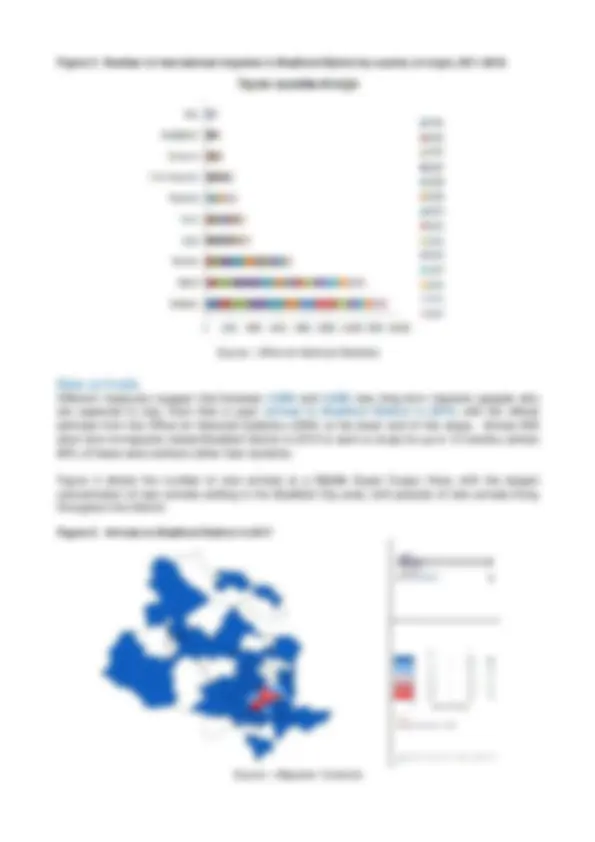




Study with the several resources on Docsity

Earn points by helping other students or get them with a premium plan


Prepare for your exams
Study with the several resources on Docsity

Earn points to download
Earn points by helping other students or get them with a premium plan
Community
Ask the community for help and clear up your study doubts
Discover the best universities in your country according to Docsity users
Free resources
Download our free guides on studying techniques, anxiety management strategies, and thesis advice from Docsity tutors
An overview of migration patterns and population change in bradford district, focusing on international and internal migration trends. The data is based on statistics from the office for national statistics and covers the period from 2011 to 2017. The document highlights the number of migrants from different countries, the reasons for migration, and the impact on the local community. It also includes figures and charts to illustrate the trends.
Typology: Exercises
1 / 4

This page cannot be seen from the preview
Don't miss anything!



Population change in Bradford District is driven mainly by natural change resulting from the difference between the number of births occurring in the District and the number of deaths in each year. Although natural change is high, population growth is offset to some extent by the movement of people away from the District to other parts of the UK. In 2017 there were around 3,300 more births than deaths. Net internal migration (the movement of residents from one local authority to another) was – 2,700 people. Net international migration (the movement of people from one country to another) saw 1,700 more people enter the District than leave it. Figure 1: Migration in Bradford District Source: Office for National Statistics
More people are moving to Bradford District from abroad. Net international migration has slowly been increasing over recent years, from +1,201 people in 2011 to +1,685 people in 2016. Although the number of people moving from Bradford District to other parts of the UK outnumbers the number of people moving into the District from other UK locations, the number of people moving into the District has been increasing in recent years. In 2011 net internal migration was nearly - 4,000 people but had increased to just over - 2,700 people in 2016. Figure 2 : Number of migrants in Bradford District, 2011- 2016 Source: Office for National Statistics
Trend data over the last 13 years shows that most people who have successfully registered to live in Bradford District have come from Pakistan followed by Poland and Slovakia. Opening up the labour market to EU Accession states in 2004 led to a large influx of economic migrants who overtook the number of migrants from India. Within the last year the number of applications from European migrants has decreased. The number of applications from Polish nationals has in particular decreased by over one-third, whilst applications from Romanian nationals has decreased by more than 30%. In addition to the number of people from other countries obtaining a National Insurance number, the Council’s electoral register does record people from Central and Eastern European (CEE) countries who are eligible to vote in EU elections, but not UK elections. The last electoral register had 8,415 people from CEE communities (50% are from the Polish community, 15% Slovakian, 12% Latvian, 7% Romanian, 6% Lithuanian, 5% Czech, 3% Bulgarian and 1% Croatian, the Slovenian and Croatian communities had less than 1%). The wards with the highest number of people from CEE communities on the electoral register are City, Tong, Little Horton and Bowling & Barkerend.
New migrant workers arriving in Bradford District totalled approximately 4,800 in 2016, a small increase on the previous year. There was a small increase in arrivals from Accession and other European countries, compared to small decreases from most other regions of the world. The biggest change in individual nationalities was an increase of around 100 arrivals from Romania compared with 2015. The top country of origin continues to be Poland with 854 arrivals in 2016, followed by Pakistan (660 arrivals) and Romania (639 arrivals). Fewer international students are coming to study in Bradford District. 1,605 international students were registered at Higher Education institutions for the academic year ending in 2017. This continues a declining trend. Around twice as many students are from outside the EU than from another EU member state. Supporting resources Understanding Bradford District - https://ubd.bradford.gov.uk/about-us/population/ Migration Yorkshire - http://www.migrationyorkshire.org.uk/ M